air conditioning VOLVO V60 2014 Owners Manual
[x] Cancel search | Manufacturer: VOLVO, Model Year: 2014, Model line: V60, Model: VOLVO V60 2014Pages: 442, PDF Size: 13.85 MB
Page 6 of 442
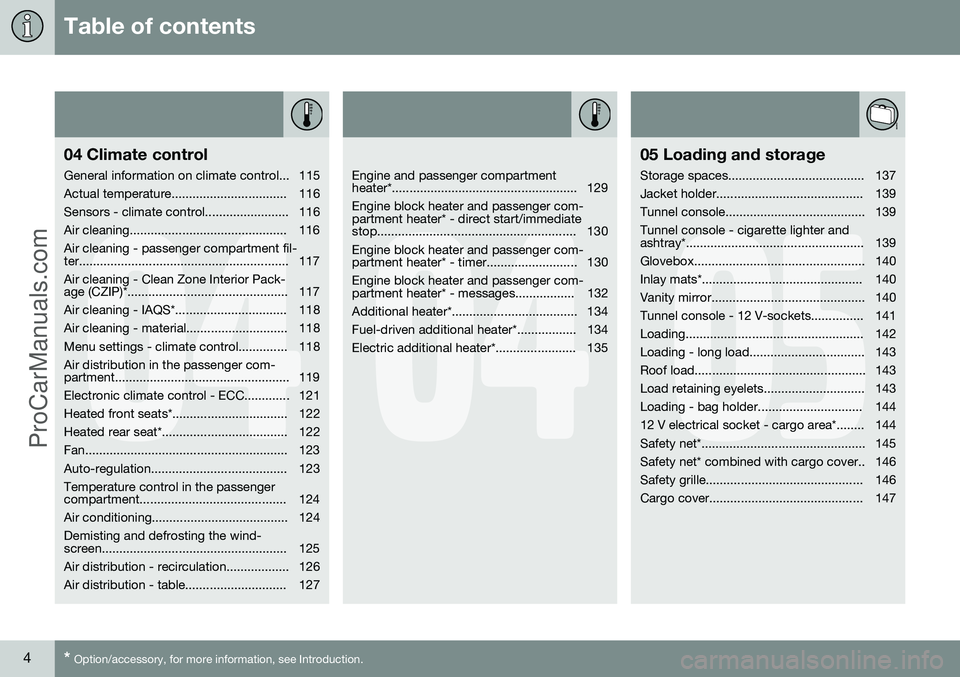
Table of contents
4* Option/accessory, for more information, see Introduction.
04
04 Climate control
General information on climate control... 115
Actual temperature................................. 116
Sensors - climate control........................ 116
Air cleaning............................................. 116Air cleaning - passenger compartment fil-
ter............................................................ 117 Air cleaning - Clean Zone Interior Pack-
age (CZIP)*.............................................. 117
Air cleaning - IAQS*................................ 118
Air cleaning - material............................. 118
Menu settings - climate control.............. 118Air distribution in the passenger com-
partment.................................................. 119
Electronic climate control - ECC............. 121
Heated front seats*................................. 122
Heated rear seat*.................................... 122
Fan.......................................................... 123
Auto-regulation....................................... 123Temperature control in the passenger
compartment.......................................... 124
Air conditioning....................................... 124Demisting and defrosting the wind-
screen..................................................... 125
Air distribution - recirculation.................. 126
Air distribution - table............................. 127
04
Engine and passenger compartment
heater*..................................................... 129 Engine block heater and passenger com- partment heater* - direct start/immediate
stop......................................................... 130 Engine block heater and passenger com-
partment heater* - timer.......................... 130 Engine block heater and passenger com-
partment heater* - messages................. 132
Additional heater*.................................... 134
Fuel-driven additional heater*................. 134
Electric additional heater*....................... 135
05
05 Loading and storage
Storage spaces....................................... 137
Jacket holder.......................................... 139
Tunnel console........................................ 139Tunnel console - cigarette lighter and
ashtray*................................................... 139
Glovebox................................................. 140
Inlay mats*.............................................. 140
Vanity mirror............................................ 140
Tunnel console - 12 V-sockets............... 141
Loading................................................... 142
Loading - long load................................. 143
Roof load................................................. 143
Load retaining eyelets............................. 143
Loading - bag holder.............................. 144
12 V electrical socket - cargo area*........ 144
Safety net*............................................... 145
Safety net* combined with cargo cover.. 146
Safety grille............................................. 146
Cargo cover............................................ 147
ProCarManuals.co’
Page 99 of 442

03 Instruments and controls
03
* Option/accessory, for more information, see Introduction.97
Automatic dimming*Bright light from behind is automatically dimmed by the rearview mirror. The controlfor manual dimming is not available on mir-rors with automatic dimming. The rearview mirror contains two sensors - one forward facing and one rearward facing -that work together to identify and eliminatedazzling light. The forward facing sensordetects ambient light, while the rearward fac-ing sensor detects the light from vehicleheadlights behind.
NOTE
If the sensors are obscured by e.g. parking permits, transponders, sun visors orobjects in the seats or in the cargo area insuch a way that light is prevented fromreaching the sensors, then the dimmingfunction of the interior rearview and doormirrors is reduced.
The compass (p. 97) can only be specified for a rearview mirror with automatic dimming.
Related information
• Door mirrors (p. 94)
Compass*
The rearview mirror contains an integrated display that shows the compass direction inwhich the front of the car is pointing.
Operation
Rearview mirror with compass.
The upper right-hand corner of the rearview mirror has an integrated display that showsthe compass direction in which the front ofthe car is pointing. Eight different directions are shown with English abbreviations:
N(north), NE (north east), E (east), SE (south
east), S (south), SW (south west), W (west)
and NW (north west).
The compass is activated automatically when the car is started or when key position II is
active, see Key positions - functions at differ-ent levels (p. 70). To deactivate/activate thecompass - press in the button on the under- side of the mirror using a paper clip for exam-ple.
CalibrationThe compass may need calibrating to showthe correct compass direction. The earth is divided into 15 magnetic zones. The compass should be calibrated if the caris moved across several magnetic zones. Proceed as follows to perform calibration:
1. Stop the car in a large open area free
from steel structures and high-voltage power lines.
2. Start the car and switch off all electrical equipment (air conditioning, wipers, etc.)and ensure that all doors are closed.
NOTE
Calibration may fail or not start at all if electrical equipment is not switched off.
3. Hold the button on the underside of therearview mirror depressed approx. 3 seconds. The number of thecurrent magnetic zone is shown.
ProCarManuals.co’
Page 117 of 442

04 Climate control
04
* Option/accessory, for more information, see Introduction.115
General information on climate control
The car is equipped with electronic climate
control (p. 121). The climate control systemcools or heats as well as dehumidifies the airin the passenger compartment.
NOTE
Air conditioning (AC) (p. 124) can be switched off, but to ensure the best possi-ble climate comfort in the passenger com-partment, and to prevent the windowsfrom misting, it should always be switchedon.
To bear in mind
• To ensure that the air conditioning works optimally, the side windows and sunroof*should be closed.
• Total airing function (p. 166) opens/closes all side windows simultaneouslyand can be used for example to quicklyair the car during hot weather.
• Remove ice and snow from the climatecontrol system air intake (the grillebetween the bonnet and the windscreen).
• In warm weather, condensation from theair conditioning may drip under the car.This is normal.
• When the engine requires full power, e.g.for full acceleration or driving uphill with atrailer, the air conditioning can be tempo-rarily switched off. There may then be a temporary increase in temperature in thepassenger compartment.
• Remove misting on the insides of the win-dows primarily by using the defrosterfunction (p. 125). To reduce the risk ofmisting, keep the windows clean and usewindow cleaner.
Cars with Start/Stop*With an auto-stopped (p. 279) engine certain equipment may have its function temporarilyreduced, e.g. climate control fan speed (p.123).
Cars with ECO*Certain equipment may have its function tem-porarily reduced or deactivated when theECO (p. 288) function is activated, e.g. the airconditioning (p. 124).
NOTE
When the ECO function is activated, sev- eral parameters in the climate control sys-tem's settings are changed, and severalelectricity consumer functions are reduced- a press of the
AC button resets the cli-
mate control system, but then withreduced AC function.
Related information
• Actual temperature (p. 116)
• Menu settings - climate control (p. 118)
• Electronic climate control - ECC (p. 121) •
Air distribution in the passenger compart- ment (p. 119)
• Air cleaning (p. 116)
ProCarManuals.co’
Page 123 of 442

04 Climate control
04
121
Electronic climate control - ECC
ECC (Electronic Climate Control) maintains the temperature selected in the passengercompartment and can be set separately forthe driver's side and passenger side.
The auto function is used to automaticallycontrol temperature, air conditioning, fanspeed, recirculation and air distribution.
Temperature control (p. 124), left-hand side
Electrically heated front seat (p. 122), left side
Max. defroster (p. 125)
Fan (p. 123)
Air distribution (p. 119) - ventilation floor
Air distribution - air vent instrument panel
Air distribution - defroster windscreen
Rear window and door mirror defrost- ers (p. 96)
Electrically heated front seat (p. 122), right side
Temperature control (p. 124), right-hand side
Recirculation (p. 126)
AUTO
- Automatic climate control (p.
123)
AC - Air conditioning on/off (p. 124)
ProCarManuals.co’
Page 125 of 442
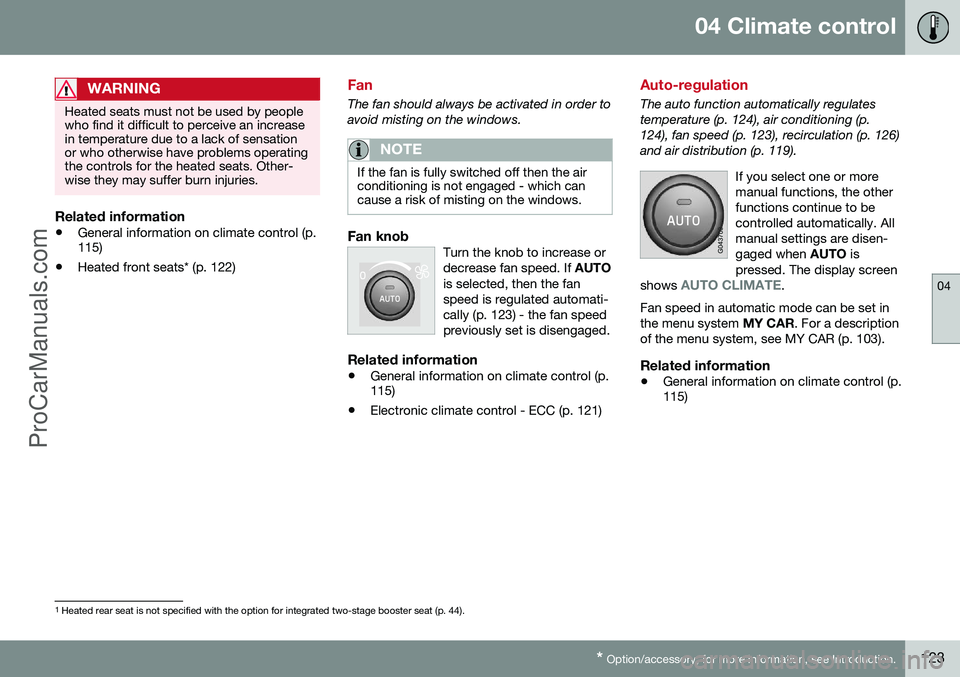
04 Climate control
04
* Option/accessory, for more information, see Introduction.123
WARNING
Heated seats must not be used by people who find it difficult to perceive an increasein temperature due to a lack of sensationor who otherwise have problems operatingthe controls for the heated seats. Other-wise they may suffer burn injuries.
Related information
• General information on climate control (p. 115)
• Heated front seats* (p. 122)
Fan
The fan should always be activated in order to avoid misting on the windows.
NOTE
If the fan is fully switched off then the air conditioning is not engaged - which cancause a risk of misting on the windows.
Fan knobTurn the knob to increase or decrease fan speed. If
AUTO
is selected, then the fanspeed is regulated automati-cally (p. 123) - the fan speedpreviously set is disengaged.
Related information
• General information on climate control (p. 115)
• Electronic climate control - ECC (p. 121)
Auto-regulation
The auto function automatically regulates temperature (p. 124), air conditioning (p.124), fan speed (p. 123), recirculation (p. 126)and air distribution (p. 119).
If you select one or moremanual functions, the otherfunctions continue to becontrolled automatically. Allmanual settings are disen-gaged when AUTO is
pressed. The display screen
shows
AUTO CLIMATE.
Fan speed in automatic mode can be set in the menu system MY CAR. For a description
of the menu system, see MY CAR (p. 103).
Related information
• General information on climate control (p. 115)
1
Heated rear seat is not specified with the option for integrated two-stage booster seat (p. 44).
ProCarManuals.co’
Page 126 of 442
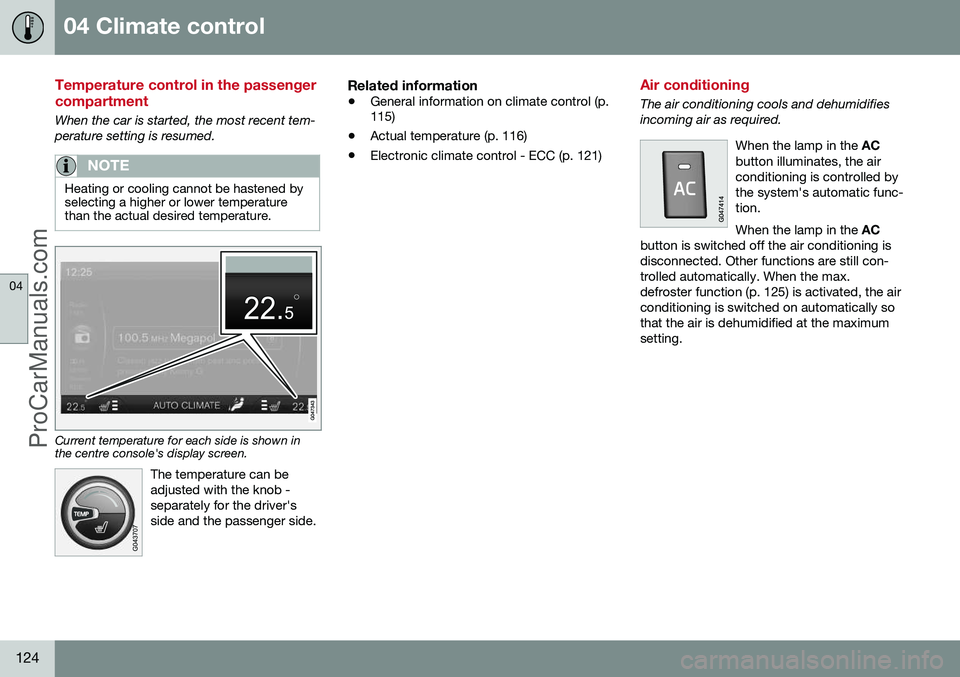
04 Climate control
04
124
Temperature control in the passenger compartment
When the car is started, the most recent tem- perature setting is resumed.
NOTE
Heating or cooling cannot be hastened by selecting a higher or lower temperaturethan the actual desired temperature.
Current temperature for each side is shown in the centre console's display screen.The temperature can be adjusted with the knob -separately for the driver'sside and the passenger side.
Related information
•General information on climate control (p. 115)
• Actual temperature (p. 116)
• Electronic climate control - ECC (p. 121)
Air conditioning
The air conditioning cools and dehumidifies incoming air as required.
When the lamp in the AC
button illuminates, the airconditioning is controlled bythe system's automatic func-tion. When the lamp in the AC
button is switched off the air conditioning is disconnected. Other functions are still con-trolled automatically. When the max.defroster function (p. 125) is activated, the airconditioning is switched on automatically sothat the air is dehumidified at the maximumsetting.
ProCarManuals.co’
Page 127 of 442

04 Climate control
04
* Option/accessory, for more information, see Introduction.125
Demisting and defrosting the windscreen
Heated windscreen* and max. defroster are used to quickly remove misting and ice fromthe windscreen and side windows.
The selected setting is shown in the centre con- sole's screen.
Electric heating*
Max. defroster
The light in the defroster but- ton illuminates when thefunction is active. Press the button repeatedly in order to activate the func-tion.
For cars without heated windscreen:• Air flows to the windows - symbol (2) illu- minates in the screen.
• Switch off the function - no symbol illumi-nates.
For cars with heated windscreen:
• Start the heating for the windscreen 2
-
symbol (1) illuminates in the screen.
• Start the heating for the windscreen 2
and
air flow to the windows - symbols (1) and(2) illuminate in the screen.
• Switch off the function - no symbol illumi-nates.
NOTE
Heated windscreen and IR window (p. 17) may have an impact on the performance oftransponders and other communicationequipment.
NOTE
A triangular area at the end of each side of the windscreen is not electrically heated,where de-icing may take longer.
NOTE
Electrically heated windscreen is not avail- able when the engine is auto-stopped (p.279).
The following also takes place in order to pro- vide maximum dehumidification in the pas-senger compartment:
• the air conditioning is automatically engaged
• recirculation and the air quality systemare automatically disengaged.
NOTE
The noise level increases as the fan is operating at max.
When the defroster is switched off the climate control returns to the previous settings.
Related information
• General information on climate control (p. 115)
2
If the character C is shown in the rearview mirror when the heated windscreen is activated then the compass (p. 97)* must be recalibrated.
ProCarManuals.co’
Page 129 of 442

04 Climate control
04
}}
127
Air distribution - table
Three buttons are used to select the distribu- tion (p. 119) of the air.
Air distributionUse
Air to windows. Some air flows from the air vents. The air is not recirculated. Air conditioning is always engaged.to remove ice and misting quickly.
Air to windscreen, via defroster vent, and side windows. Some air flows from the air vents.to prevent misting and icing in a cold and humid climate, (not at too low fan speed to enable this).
Airflow to the windows and from the dashboard air vents.to ensure good comfort in warm, dry weather.
Airflow to the head and chest from dashboard air vents.to ensure efficient cooling in warm weather.
ProCarManuals.co’
Page 300 of 442
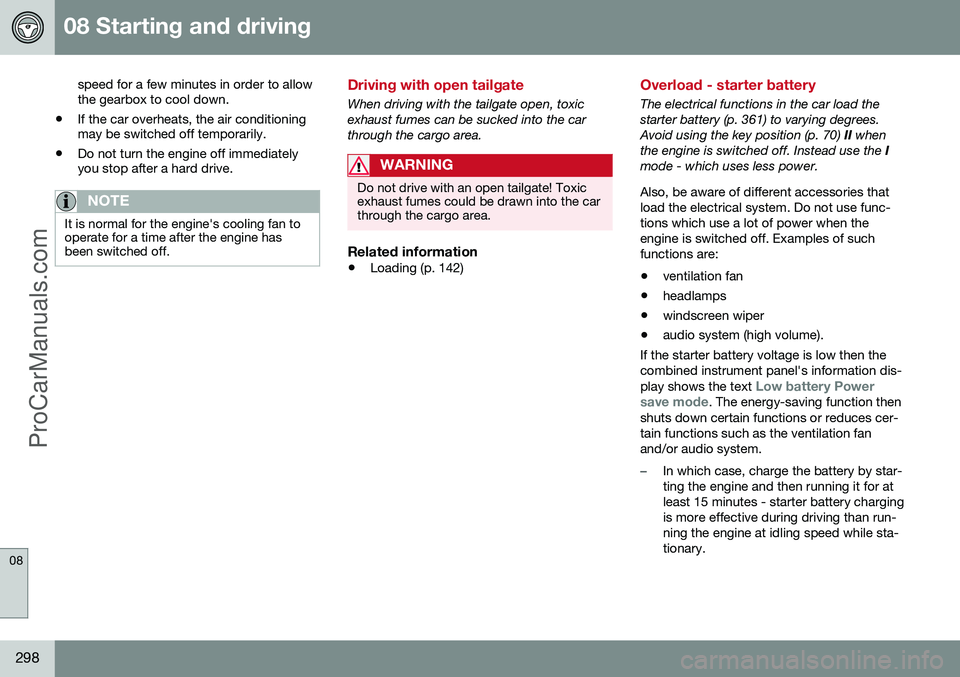
08 Starting and driving
08
298
speed for a few minutes in order to allow the gearbox to cool down.
• If the car overheats, the air conditioningmay be switched off temporarily.
• Do not turn the engine off immediatelyyou stop after a hard drive.
NOTE
It is normal for the engine's cooling fan to operate for a time after the engine hasbeen switched off.
Driving with open tailgate
When driving with the tailgate open, toxic exhaust fumes can be sucked into the carthrough the cargo area.
WARNING
Do not drive with an open tailgate! Toxic exhaust fumes could be drawn into the carthrough the cargo area.
Related information
•Loading (p. 142)
Overload - starter battery
The electrical functions in the car load the starter battery (p. 361) to varying degrees.Avoid using the key position (p. 70)
II when
the engine is switched off. Instead use the I
mode - which uses less power. Also, be aware of different accessories that load the electrical system. Do not use func-tions which use a lot of power when theengine is switched off. Examples of suchfunctions are: • ventilation fan
• headlamps
• windscreen wiper
• audio system (high volume).
If the starter battery voltage is low then the combined instrument panel's information dis- play shows the text
Low battery Power
save mode. The energy-saving function then
shuts down certain functions or reduces cer- tain functions such as the ventilation fanand/or audio system.
–In which case, charge the battery by star- ting the engine and then running it for atleast 15 minutes - starter battery chargingis more effective during driving than run-ning the engine at idling speed while sta-tionary.
ProCarManuals.co’
Page 354 of 442
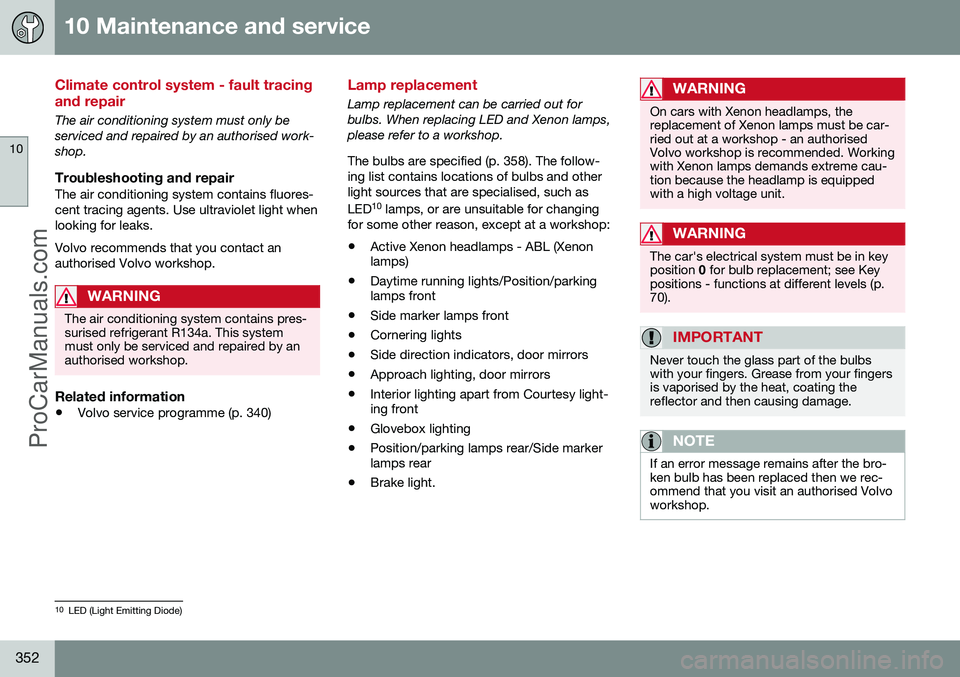
10 Maintenance and service
10
352
Climate control system - fault tracing and repair
The air conditioning system must only be serviced and repaired by an authorised work-shop.
Troubleshooting and repairThe air conditioning system contains fluores-cent tracing agents. Use ultraviolet light whenlooking for leaks. Volvo recommends that you contact an authorised Volvo workshop.
WARNING
The air conditioning system contains pres- surised refrigerant R134a. This systemmust only be serviced and repaired by anauthorised workshop.
Related information
•Volvo service programme (p. 340)
Lamp replacement
Lamp replacement can be carried out for bulbs. When replacing LED and Xenon lamps,please refer to a workshop. The bulbs are specified (p. 358). The follow- ing list contains locations of bulbs and otherlight sources that are specialised, such as LED 10
lamps, or are unsuitable for changing
for some other reason, except at a workshop:
• Active Xenon headlamps - ABL (Xenon lamps)
• Daytime running lights/Position/parkinglamps front
• Side marker lamps front
• Cornering lights
• Side direction indicators, door mirrors
• Approach lighting, door mirrors
• Interior lighting apart from Courtesy light-ing front
• Glovebox lighting
• Position/parking lamps rear/Side markerlamps rear
• Brake light.WARNING
On cars with Xenon headlamps, the replacement of Xenon lamps must be car-ried out at a workshop - an authorisedVolvo workshop is recommended. Workingwith Xenon lamps demands extreme cau-tion because the headlamp is equippedwith a high voltage unit.
WARNING
The car's electrical system must be in key position
0 for bulb replacement; see Key
positions - functions at different levels (p.70).
IMPORTANT
Never touch the glass part of the bulbs with your fingers. Grease from your fingersis vaporised by the heat, coating thereflector and then causing damage.
NOTE
If an error message remains after the bro- ken bulb has been replaced then we rec-ommend that you visit an authorised Volvoworkshop.
10 LED (Light Emitting Diode)
ProCarManuals.co’